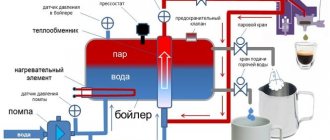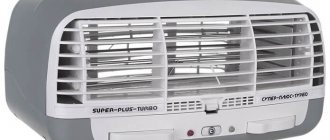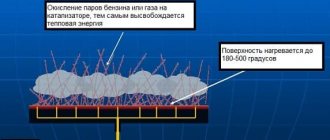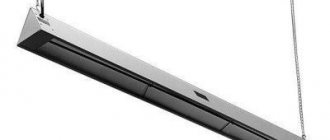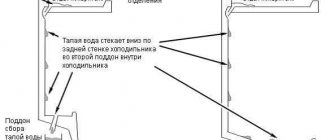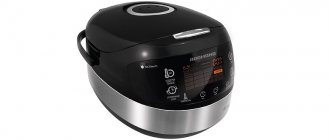Classifications
The modern range of products is distinguished by a variety of designs and technical solutions. It is customary to classify the model range of quartz heaters according to several important parameters and consumer properties. These classification characteristics include: mounting location, dimensions and power consumption.
At the location of attachment
Existing IR heaters are divided into products for stationary mounting (on the wall or ceiling) and floor placement.
In the first case, brackets and mounting hardware are used, in the second - a mobile stand. A wall with a gap from the floor of ≥ 20 cm to ensure air flow is most often chosen as the location for a monolithic MKTEN.
By size
Infrared devices can have a variety of sizes, for example, rectangular 350x460x315 mm or elongated rectangular 880x260x125 mm.
The dimensions of monolithic slabs vary among different manufacturers, but medium format panels are usually produced in sizes 60x35 cm and a thickness of 2.5 cm
Power, which are the most economical (energy saving)
If heaters with water and oil coolant consume from 0.8 to 2 kW, then quartz units are limited to 0.4-0.6 kW. This power consumption will be required to heat a standard insulated room with an area of 12–18 m². Accordingly, energy costs will be several times lower. Today, quartz heaters are the most energy-saving among competing analogues for this purpose.
Carbon-quartz heater
The innovative carbon-quartz heater that went on sale is similar in structure and operating principle to a monolithic panel. The difference is in the heating element - it is made of carbon fiber. A special feature of this material is its unlimited operating time even with a cracked case - oxidation processes leading to burnout of carbon fibers proceed several orders of magnitude slower than with metal wire.
Characteristics. The technical characteristics of each heating device are individual. Therefore, we present average data for all types of heaters, and we will show individual data when considering a specific model in the “Model Rating” section:
- power - 0.4-5.0 kW;
- efficiency factor (efficiency) - more than 90%;
- weight - 1.55-25.0 kg;
- heating area - 8-45 m2;
- filament temperature - 250-1200oC;
- class of protection against electric shock - 1;
- housing protection class - IP 20;
- dimensions: length - 480-1450 mm; height - 45-535 mm; thickness - 25-275 mm.
Size and dimensions
It is quite logical to assume that the greater the power of the heater, the larger its overall dimensions will be.
However, note that in many models this only changes the width. But the height and thickness remain unchanged
This is a very important point when placing heating on the wall and integrating it into other design elements.
At the same time, from leading manufacturers, even with the same power, you can always choose:
low and very wide, for large windows or stained glass windows
and vice versa - tall and narrow in small rooms
For example, two models with the same power of 2 kW, but what a difference in the width of the case. Which one do you think will heat better?
Infrared quartz heaters
Unlike monolithic ones, infrared-type quartz devices use tubular heating elements. Their design can differ significantly from each other, and therefore several types of such devices are distinguished.
For example, in the past, electrical appliances with an open spiral wound on a ceramic base were often used to heat rooms. Such devices are a fire hazard and are currently strictly prohibited for use. In addition, they reduce the amount of oxygen in the room and increase the percentage of carbon dioxide, adversely affecting the health of the people inside.
Another type is infrared devices with a quartz tube, where the heating element is again a tungsten spiral - but here it is enclosed in a sealed vacuum tube made of special glass. Since there is no air in the tube, no combustion process occurs inside it. Such devices are relatively safe and heat the room quite effectively, but they also have a number of disadvantages. One of them is the strong heating of the tube during operation (up to 700 °C), which leads to the combustion of microparticles and dust falling on its surface. Other disadvantages: low level of protection from moisture and a rather short service life, averaging two or three years.
One of the most practical and modern options for infrared quartz heaters can be considered heat-emitting plates. In the aluminum profile of such a device there is a tubular electric heater (TEH) built into it, the heating of which does not occur at full power, and therefore is accompanied by moderate soft radiation. Such devices, although somewhat inferior in thermal effect to the previous version, are very environmentally friendly and completely safe in terms of fire. These devices do not consume oxygen, do not burn dust, and their only drawback can be considered a slight cracking sound during operation, which occurs due to different expansion of the body and tube of the heating element when heated.
In general, modern models of infrared quartz heaters are quite convenient to use: to get started, just place the device in the room and connect it to a power source. Adjusting the operating modes of such devices is very simple, and the efficiency exceeds 90%
Apart from the rather high energy costs, these heaters are otherwise one of the best options for warming living spaces.
When purchasing an infrared quartz heating device, you should pay close attention to the quality of the body, plate, heater and other elements. In particular, the body of a quality device must be powder coated, not only on the outside, but also on the inside, and there should not be the slightest sign of rust or damage.
The plate should normally have a uniform color, without spots or washouts. A high-quality heating element is made of stainless steel; if it is made of ordinary metal, then in this case the device will be unsuitable for use in rooms with high humidity
In addition, it is important to pay attention to the appearance of the wires and the quality of their fastening.
Harmfulness of quartz heaters
Speaking about the dangers of these household devices, they argue about the combustion of oxygen and harmful radiation affecting health. To refute it, you need to understand the material that makes up household appliances of this type.
Monolithic devices consist of pressed quartz with the addition of white clay and marble chips. The heating element is mounted inside the stove. Quartz sand completely absorbs harmful radiation and does not dry out the air. The absence of combustion proves that oxygen is not burned from the air. A heater of this type cannot harm your health. When installing the device, the device is hung on the wall; you can even get burned from touching it only by deliberately leaning against it for a long time. Using a protective screen completely eliminates this risk.
Infrared models of quartz devices consist of a tube consisting of quartz glass and a nichrome heater located in it. The walls of this tube absorb most of the harmful radiation, but their thickness does not block it completely. By following simple rules, you can avoid exposure to radiation.
What is an infrared quartz heater
A convenient and economical device for heating a room is an infrared heater. These devices have their advantages and disadvantages. The disadvantages of quartz heaters of this type are compensated by their advantages:
- They are universal in use;
- Made from quality materials;
- Safe for home residents;
- They are durable and economical.
Structurally, the main element of the device is a special emitter - a spiral in a quartz tube, which directs a flow of infrared rays to heat the room. To heat the room effectively, use a reflector. This device allows you to properly distribute heat in the room, thanks to the material used - high-quality metal with good heat resistance and reflectivity. In addition, the reflector helps protect the heater body from overheating. Reviews of quartz heaters confirm that devices of this type are popular - they are convenient and safe to use.
Infrared quartz heaters make it possible to divide a room into different heating zones. Many consider this an important advantage of heaters of this type - it is possible to arrange local heating of the room. For example, places to work or relax. At the same time, the rest of the room is also heated, but not so intensely.
Infrared quartz heaters allow you to comfortably arrange your home and save energy. Such heaters heat evenly - without a significant difference between the temperature near the floor and under the ceiling. They heat a small area quickly. The radiant heat effect is felt almost instantly when you turn on your infrared heater.
Disadvantages and limitations of infrared quartz heaters:
- Infrared radiation travels in a straight line, so they will only affect objects in direct access. Infrared heaters have an element that shines heat directly onto you. If the heater is above you, for example, and you are sitting at a desk, your feet may be cold.
- Sometimes such heaters are considered unaesthetic, but for a summer house or cottage this option is considered successful.
- It is better to place such heaters in a place inaccessible to children.
- Such devices are suitable for small spaces.
In any case, an infrared heater will last longer and be safer than its oil counterpart. Using an infrared quartz heater, you can evenly warm the room.
Quartz heaters are most useful if you want to provide heat for one person or one room. The heater operates silently and does not create vibration. Some devices are equipped with a timer that allows you to regulate the operation of the product. The harm from an infrared heater is minimal.
A review of quartz heaters for the home revealed that most of them have advantageous advantages in comparison with other types of heating devices.
Infrared technology does not require any chemicals to work and the device does not pollute indoor air.
Which quartz heater is better to choose for a summer cottage? Depending on your wishes, you can choose the option of an infrared or conventional quartz heater.
Cost-effectiveness of quartz heaters
The next myth is about the financial feasibility of using these devices. High electricity tariffs and prices for household appliances cast doubt on the purchase of a quartz-based device. First, let's look at the average price of heaters.
Monolithic devices are made of inexpensive materials, for this reason the market price is quite low compared to many other types of devices. The price of infrared models is slightly higher than that of monolithic ones, which is due to more expensive materials.
In addition to the price of the device, you need to take into account the electricity consumption. For a monolithic heater it is 2.54 kW per day when using a thermostat. Infrared consumption is slightly higher - 8 kW per day, also when using a thermostat. Thus, the energy consumption will not be too high per month even in conditions of constant operation of the device. Given the efficiency of 98%, energy consumption will only be used to produce heat. In this case, unnecessary waste of energy is practically eliminated.
Based on the above facts, it can be argued that the use of quartz heaters is beneficial from an economic point of view.
Operating principle of a quartz heater
The principle on which the heating device operates is based on directed infrared radiation. Its essence is similar to the natural process of heating the earth by the Sun.
To better imagine the operating principle of the unit, one cannot help but recognize its constituent elements and their method of functioning.
| Element | Characteristic |
| External design | Usually the appearance is represented by a panel decorated with decorative embossing or pattern. There are some models in which the outer panel is smooth and painted. The thickness of the slab is usually 2.5 centimeters. Equipped with special fastenings for the wall, it also has a stand on which it can be placed stably on the floor. |
| A heating element | The alloy used in production is nichrome (nickel and chromium). Filling with quartz sand provides protective functions from external factors, and also enhances heat transfer. Such an element in the design is installed in a flask, which is located in the lamp, or can be placed in a monolithic slab consisting of quartz. |
| Scattering device | On the back side of the device, behind the flask and plate, there is a metal plate that acts as a reflective element, which allows the device to acquire a certain directionality of radiation. |
| Thermostat | Responsible for heating efficiency and reduces consumption by up to 40%. Some models have an offline mode in which the equipment operates continuously. This is achieved due to the fact that they have a special control unit built into them. In other models, it is necessary to connect a thermostat. Additional devices that ensure safety are sensors that protect the device from overheating. |
Video - quartz heater
https://youtube.com/watch?v=uZPRjf3X4P0
There are varieties of quartz type heaters, which allows you to vary when choosing the required type of device specifically for the desired parameters:
- Monolithic – is a slab;
- Lamp - made in the form of a lamp.
There is also some division into subclasses of a single type of quartz heaters. There are:
- Monolithic;
- Infrared.
The first version of a quartz heater can be characterized as follows:
- The basis of the device is a prepared mixture of quartz sand in combination with other components. They can be white clay (kaolin) or dolomite (crushed marble), different manufacturers use different components;
- After the mixture is prepared, it is sintered, before being thoroughly dried and compacted;
- A spiral made of nickel-chrome alloy is filled with this solution;
- To make the panel, a solution is used, the main component of which is quartz sand.
The operating principle of such a device is very simple and is represented by the following process algorithm:
- Due to the fact that the nickel-chrome spiral heats up, the overall surface of the device heats up.
- The temperature threshold reaches 95 degrees.
- At this level of temperature, infrared radiation begins to occur in combination with convective heating of the air space.
As for the second type of quartz heater, the quartz variety is characterized by the following parameters:
- A tungsten helix is located in a quartz pipe;
- The heat flow propagates according to the principle of radiation, namely, contact with air space is excluded. Transmission occurs directly to objects and people.
The fact that the spiral is placed in a quartz tube makes it possible to maintain the safety of the equipment. This is due to the fact that when heated, access to dust and dirt particles flying in the air is blocked to reach the hot tungsten spiral. In addition, this design allows you to extend the service life of the device due to the fact that the spiral is not damaged by any external factors.
Heaters of this type are good for use if a room needs heating, where constant ventilation is also necessary, or for some reason the air circulates very strongly. They heat the room locally.
Types of quartz heaters
At the moment, users can buy 2 types of quartz heating devices in stores or from manufacturers:
- monolithic in the form of flat panels up to 25 mm thick with a textured pattern;
- infrared, equipped with a heating element in a glass tube.
First of all, let’s look at the question of how the heater got its beautiful name “quartz”. The answer is simple: in the manufacture of both types of heaters, ordinary quartz sand is used. In an infrared device, a glass tube is made from it, where an electric heater is placed. In monolithic panels, sand is part of the solution from which they are cast.
Window glass is also made from quartz sand
For reference. The basis for making any glass is natural silicon, also known as sand. You can call the windows in your apartment quartz and you will be right, because the translucent part is also made of sand.
In addition to the name, both types of heating devices have other common features:
- They use nichrome wire (an alloy of nickel and chromium) as a heating element.
- The devices can be used both wall-mounted and floor-mounted on a stand.
- To limit the temperature in the room, the products are equipped with thermostats.
Monolithic painted heater
Operating principle of monolithic heaters
The heating element here is a nichrome filament with increased resistance, enclosed in a non-flammable insulating sheath. It is embedded inside a slab made from a solution of sand and white kaolin clay. The mixture, placed in a special form, undergoes pressing and heat treatment (sintering), resulting in a solid ceramic plate - a quartz heater with a textured pattern on the front side.
For reference. Manufacturers add various fillers to the solution at their discretion, for example, dolomite or marble chips. The surface of the panel is painted in the desired color or remains in the basic version - white.
A close-up of the textured pattern on the front side of the stove. The
perimeter of the stove is trimmed with a metal frame with rounded corners, where the shutdown key and connecting cable with plug are attached. The room thermostat is supplied separately from the stove (and is paid for as an option). The main technical characteristics of ceramic quartz heaters from different manufacturers are practically the same and look like this:
- power consumption – from 400 to 500 W;
- Efficiency – 99% (almost all consumed electricity is converted into heat);
- weight – from 10 to 15 kg;
- maximum surface temperature – up to 98 °C;
- overall dimensions (length / height / depth) – 60 / 35 / 2.5 cm;
- heating speed – 20 minutes (from +10 to +95 °C);
- cooling rate – 1 °C every 2 minutes.
The heating device is installed in two positions - wall-mounted and floor-mounted on a stand
Note. In advertising, manufacturers unanimously indicate daily electricity consumption in the amount of 2.5-3.6 kW. But in real life this figure does not correspond to reality; the real energy consumption is higher.
The operating principle of a monolithic quartz heater is simple: a nichrome filament heats the entire panel to the maximum temperature, causing heat to spread throughout the room in two ways - convection (heating the air) and using infrared radiation (heating all surfaces in front of the front panel of the device).
Monolithic electrical panels are evolving, and the quality of products is gradually improving. A striking example is the new Belarusian quartz-olivine heater, which has an attractive design. The natural mineral olivine is used for production. At the international exhibition BUDEXPO - 2021, the heating device of this manufacturer received the diploma “Best Innovative Product of 2018”.
The Tepleya household electric heater looks much better than products from other brands
If a thermostat is connected to the device, then when the set air temperature in the room is reached, it will turn off the heating. The stove will go into cooling mode, during which intense heat transfer continues. When the temperature drops to the lower limit, the thermostat will turn the device back on for heating.
Simple brackets for wall mounting are included with the device, but the thermostat will have to be purchased separately
In essence, a monolithic slab of quartz sand with clay is a convective-infrared heater that operates with an efficiency of 99% (like any other electric heater) and requires external control from a thermostat.
A detailed overview of heaters made in the form of plates is shown in the video:
Operating principle of an infrared heater
These household appliances have long been familiar to us by the name of the Swedish brand UFO, which has become a household name. The structure of the device is as follows: one or more glass tubes are installed horizontally (or vertically) in an oblong metal body, and nichrome heating filaments pass through them.
The semicircular surface at the back of the tubes is made of a mirror to reflect all the heat in one direction. Similar quartz heaters for home are equipped with built-in thermostats and operate according to the following algorithm:
- After turning on the device, the nichrome filament heats up and releases heat in the form of infrared radiation moving in one direction.
- First of all, surfaces and objects located in the area of action of the quartz heater are heated. The air receives heat from these surfaces, causing its temperature to gradually increase.
- When the temperature in the room reaches a user-set threshold, the built-in thermostat turns off the heating element.
- When the air in the room begins to cool, the thermostat starts the heating process again.
The appearance of infrared heaters has long been familiar to users
For reference. Tubular heaters of the UFO type have nothing in common with quartz bactericidal lamps used in medicine, and therefore do not bring any benefit to human health, as well as harm. When quartzed, hospital lamps create a powerful stream of ultraviolet radiation that destroys any microorganisms.
The heating coil of the device, which emits infrared radiation, is placed inside a glass tube for safety reasons and to increase service life. In open air, a hot filament will burn out much faster than inside a flask with an inert gas.
This is what an IR heater element looks like
So, a tubular quartz heater is a representative of infrared heating devices, not designed for convective heating of the air in the room. It is quite difficult to imagine the general technical characteristics of such devices, since they are produced in too wide an assortment.
Monolithic quartz heater: characteristics
Such a monolithic air heater in a wooden house or country house consists of modules connected in parallel. The basic equipment also includes equipment for regulating air temperature.
Such heaters can be installed both on the floor and on the wall, and they are completely fireproof. Now let's look at all the pros and cons of this type of heating apparatus. As for the negative properties, we can safely say that no disadvantages were noticed in this electric heating device, even after numerous diverse checks and experiments.
Pros:
- High heat capacity.
- Manufacturers guarantee that the electrical heating device will last a long time, and all this time it will reliably heat the house.
- Since the principle of operation is based on a simple scheme, which consists in the direct conversion of electrical energy into heat, there is no doubt that exactly as much electricity will be spent as is needed to heat the room.
- According to experts, one average monolithic quartz heater can easily heat a room whose volume does not exceed 15-16 m3.
- A unique alloy using quartz sand allows the device to radiate heat for a long time even after being disconnected from the network.
- Safety in use is explained by the fact that quartz monolithic heaters cannot heat above 90-95 ᵒC;
A special case of monolithic heating devices is a quartz battery, which also has numerous positive reviews from both specialists and the general population.
Operating rules for household heaters
The main advantage of all home heaters is safety and ease of use. Particularly popular is the portable type of device, which can be used in any room where there is an outlet.
Before connecting an electrical appliance, you must check the serviceability of all sockets in the house.
To ensure a long service life of the thermal device for space heating, it is recommended to follow the following operating rules:
- Any type of heater should be connected to a separate outlet to prevent overloading the network and melting the wires.
- The device is located at a safe distance from furniture equal to 60 cm.
- Do not operate the device under a window sill if there is a curtain or tulle made of flammable materials.
- Do not use the device to dry wet items, as this may lead to overheating of the housing and a fire hazard.
- It is not recommended to leave the device turned on uncontrolled for a long period of time. The exception is models equipped with thermostats and built-in remote control systems.
What are quartz heaters, types and principle of operation
There are two types of heaters most widely represented on the heating equipment market, the prices of which differ significantly:
- Monolithic types;
- Tube.
Each of these types of quartz heaters has strengths and weaknesses, as well as the most appropriate uses. For heating areas, it is rational to use monolithic units, and for the rapid heating of small spaces, the lamp type is more suitable.
In general, the operating principle of a quartz heater is as follows:
- Heating is carried out by a nichrome heating element. To protect against harmful environmental influences and increase the intensity of heat transfer, quartz sand is used. To place the heating element, either a special flask or a monolithic quartz plate is used.
- The role of the mirror is played by a metal plate placed on the back of the flask or behind the monolithic block. By reflecting infrared rays, this plate creates the effect of directed radiation.
- The presence of a thermostat allows you to significantly reduce heating costs. Some models have a built-in thermostat, while some require the use of additional control units.
A monolithic quartz heater visually resembles an ordinary wall-mounted radiator. Inside the housing there is a heating element placed in pressed sand. Thanks to this design solution, the heating element is completely isolated from environmental influences, which has a positive effect on the service life of the latter. Heating of the room with such a heater is carried out due to air convection.
Infrared models work as generators of infrared radiation, which causes heating of surrounding objects. The use of such types for complete heating of a room is not advisable, but for heating specific zones their use is quite justified.
Like any other devices, they have their advantages and disadvantages, but rational use allows you to minimize the negative aspects.
Tube quartz heaters
The design feature of these devices is reflected in the name of the type - lamp devices, in which special lamps with a quartz glass body are used as a heating element, emitting heat and ultraviolet radiation, placed in a housing with a reflector to direct the radiation.
Quartz lamp device
The heating element of a quartz heater consists of a spiral made of a nickel-chromium alloy - nichrome and placed in a quartz glass housing.
This type of device reaches maximum heating power in just 30 seconds after being plugged in and cools down just as quickly after the device is turned off. Consequently, the material of the lamp bulb (tube) is exposed to thermal shock both when the device is turned on and off. That is why the body of the heating element (lamp) is made of quartz glass, capable of withstanding instantaneous heating or cooling of 1000 degrees, and the nichrome spiral in a quartz tube is placed under vacuum conditions to prevent burnout during heating.
The diameter of quartz glass tubes can be in the range of 8 – 16 mm, the minimum/maximum length of the flask is 100 mm/1000 mm, the supply voltage is 220/230, 110, 12, 24 and 400 V.
On average, one tube quartz heater is designed to heat 18 cubic meters. volume of the room, and when purchasing you need to proceed from these figures. As for electricity consumption, such a unit with a thermostat, when used as the main and only heating device, consumes 2.5 - 3.5 kW per day to heat this volume.
When purchasing a quartz heater and calculating the required power, it is convenient to use the approximate formula for calculating the calculation - 1 kW per 10 sq. m. area.
Design of tube quartz heaters
In terms of design, electric quartz heaters are made portable or designed for installation on a wall or even a ceiling.
Portable devices are considered more practical and functional, but they are inferior to wall-mounted and ceiling-mounted devices in terms of ease of use - there is always the possibility of the device accidentally tipping over or damaging the portable electrical cable. However, installing wall or ceiling devices requires certain installation skills and ensuring safety measures at the installation site and area of operation of the device. In addition, at the end of the heating season, stationary units are no longer in demand, and their periodic installation and dismantling is inconvenient.
Advantages and disadvantages of a lamp quartz heater
Due to their many advantages, improved models of these units are widely used in everyday life; consumers continue to use even outdated models.
Let's list these advantages:
- ease of operation and daily care;
- shutdown function in case of accidental overturning or overheating;
- the ability to independently replace heating elements;
- compactness and light weight – mobility;
- almost instantaneous output to a given power;
- no effect on indoor humidity;
- the harm to humans is minimal - only if the operating rules are violated;
- availability of the entire cost range of models.
Despite the constant improvement of heating devices of this type, they still have disadvantages:
- sensitive, although tied to the power of the device, electricity consumption;
- lack of autonomy - dependence on the availability of electricity in the network;
- fragility of quartz lamps, high probability of failure if accidentally dropped;
- fire hazard (if directed use near flammable objects);
- danger of electrical injury (factor of any electrical appliance);
- danger of thermal burns from accidental contact with the lamp.
TeploPlit
The heater is available in two types: without a plug (the device is connected to a thermostat or to an electric heating system); with plug (can be used as an independent, portable heating device). The device is mounted on the ceiling, wall, or placed on the floor. When you turn on the heater, heat spreads throughout the room. Designed for continuous operation.
Portable and wall mounted:
- Name: TeploPlit-M.
- Price: from 2700 rub.
- Characteristics: environmentally friendly, safe, economical. TeploPlit quartz heaters contain sand, clay, and marble.
- Pros: aesthetic appearance, efficient in operation, can be purchased at any specialized store, silent, compact.
- Cons: monolithic body quickly collapses, small heating area.
With aluminum frame:
- Name: TeploPlit.
- Price: from 2500 rub.
- Characteristics: sand heaters for home are available in white, but can be repainted in any color. The principle of operation is brick.
- Pros: the manufacturing company claims that the device will not overheat, so you can keep it on for a long time.
- Cons: low power and small heating area.
The best wall-mounted energy-saving quartz heaters for home
Wall heaters help prevent dampness in your home. Moreover, it is not necessary to turn on the device every day - one weekend is enough to completely “dry” the walls. And it’s even better if you set the thermostat to 10 degrees and then the house will always be warm and dry, even if you only appear there sporadically.
TeploPlit
Quartz heater with metal edging with rounded edges, only in white. Made from dolomite (ground marble stone), quartz sand and kaolin clay. The entire composition is molded and sintered at high temperature.
The combination of sand, clay and marble chips, on the one hand, is a plus, since the panel is not hot and it is impossible to get burned, on the other hand, the efficiency is not as high as the manufacturer claims. For a room of 12-15 m2 you need at least 2 heaters with temperature sensors.
There are 2 types of Heat Plate on sale:
- without a plug with a 50 cm power cable - the cable is connected directly to the outlet or temperature controller;
- with plug and meter power cable.
- dimensions – 25x30x600 mm;
- weight – 11 kg;
- power – 0.45 kW/h;
- heating time to 95°C – 20 minutes;
- daily consumption with a thermostat is 8-10 kW.
Pros according to customer reviews:
- fragile - cracks appear both from a push and over time;
- uneven heating;
- heavy construction;
- difficult to connect.
WarmHoff
The heating element is located inside a quartz sand monolith and first heats the monolith, which in turn gives off heat to the room. As a result, the air warms up smoothly and evenly, maintaining a normal level of humidity.
- dimensions – 25x35x650 mm;
- weight – 11 kg;
- power – 0.36 kW/h;
- heating time to 95°C – 20 minutes;
- daily consumption with a thermostat is 6.5-8 kW.
Both the main and auxiliary types of heating can be used.
It is also convenient that you can install the heater in the bathroom - splashproof class IP24, there is also built-in overheating protection
- Fire safety class 1 - the heating element is completely enclosed, isolated from contact with air;
- silent operation;
- stable due to the robust fastening system.
- small heating area - with a declared 16 m2, no more than 8 m2 are actually heated;
- heavy - requires installation on solid walls;
- small cable cross-section.
Monolithic quartz heaters
In appearance, such electrical appliances are a monolithic and rather thin (about 25 millimeters thick) panel plate with an external embossed pattern, inside which a spiral-type chromium-nickel heating element is located. Such a device is powered from the mains, and the chromium-nickel heater inside it is completely isolated from the external environment.
When electricity passes through the heating coil, heat begins to be generated, which first heats the stove itself, and then the entire room. Warming up of the stove to an operating temperature of 90-95 °C occurs within approximately 20 minutes, and cooling after disconnecting from the power supply takes much longer, about an hour and a half.
With a thickness of 2.5 centimeters, the standard length and width of monolithic quartz heaters are 61 and 34 centimeters, respectively. The device usually weighs about 10-12 kilograms, and its standard power is 0.5 kilowatts. The power of one device at normal ceiling heights is sufficient to effectively heat a room of 14-16 square meters.
If the thermostat is not included in the package when purchasing, it is recommended to purchase it additionally. The presence of this device ensures automatic regulation of the heating process and makes the operation of the unit much more economical: when the required temperature is reached, the electrical appliance turns off and continues to remain heated for quite a long time, still warming the room. After a certain period of time, the device turns on again and begins to function again using power from the mains.
Monolithic quartz heaters are usually equipped with a special stand for placement on the floor and brackets for mounting on the wall. The choice of one of these location methods depends on the preferences of the home owners.
Monolithic quartz heaters are often used for heating residential premises in country houses and private houses. They can serve as the only source of heat or in addition to other available heating methods. They are often used as an additional source of heat in multi-apartment residential buildings.
The main advantages of monolithic quartz heaters, which determined their popularity, are as follows:
- high heat capacity;
- reliability in operation;
- efficiency of space heating;
- efficiency;
- prolonged heat retention in the room due to a long cooling period;
- no harmful effects on the body;
- fire safety, due to the isolation of the heating element from the external environment;
- long service life;
- if there is a thermostat, automatic operation without the need for frequent monitoring.
If we talk about the disadvantages, then the main one can be considered the risk of burns during touch. True, due to the fact that the spiral is located in a closed space inside the device, the surface temperature of monolithic quartz heaters does not exceed 95 °C, however, nevertheless, there is a danger of getting burned on them, especially for children and animals.
In addition, despite the efficiency of such heaters compared to most other electrical heating devices, the total energy consumption during the cold winter season can be quite significant. Otherwise, monolithic quartz electric heaters are a convenient and practical heating option, designed for daily intensive use inside residential premises.
Best quartz heaters 2021
There are two types of quartz heaters - infrared and monolithic.
The first ones use a tungsten spiral placed in a quartz tube as a heating element. Such models are light in weight. Due to this, they are often used as portable ones or mounted on ceilings and walls.
The basis of the latter is a form with a nichrome spiral, into which a special composition with quartz sand is poured. They are most often mounted on walls. Such a stove heats up gradually, and after switching off, it releases heat for quite a long time.
This quartz heater serves as a good alternative to a heat gun and can almost instantly heat a room without waiting for the walls to warm up. The declared power of 1.5 kW allows you to heat and maintain heat in a room of 25 m2.
One of the advantages is that the model is quite lightweight - thanks to the comfortable handle, it can be easily transported from place to place. Both wall and floor mounting options are possible thanks to special legs. Interestingly, if it tips over, the heater will automatically turn off, which will help prevent a fire.
+ Powerful heating + Mobility
– Relatively short power cord – Large mesh mesh
This device, like other monolithic quartz heaters, is not at all afraid of water. Therefore, such a device is an ideal choice for a bathroom or toilet, where it is most often used. A power of 0.25 kW allows you to easily heat a room of up to 10 m2, while consuming electricity equal to the operation of two light bulbs.
Among the advantages, it is worth noting the ability to choose a color to match the desired interior, long-term heat retention even after switching off, as well as a harmonious design that can also perform a decorative function. However, when purchasing this heater, you should think carefully about the mounting – a device weighing 11 kg must be firmly mounted on the wall.
+ Economical + Long cooling time
– Decorative coating may crumble
This heater will help to quickly warm up a room of up to 15 m2. A power of 0.8 kW will help you stay warm in the fall or spring, when the heating in the house is still (or already) turned off.
This model is equipped with a quartz heating element that heats up quickly after turning on the power. The cord length is 1.5 m, which will allow you to place this device in the room as conveniently as possible. The reliable body is made of a combination of metal and plastic elements, and the snow-white design will make this model a wonderful addition to any interior.
+ Budget price + Economical + Power adjustment + Rollover sensor + Compact size
– Long warm-up time – May cause allergies – Relatively short cord
This is a great quartz heater for a small room. Best suited for heating your workspace or for keeping warm while sitting on the sofa in front of the TV on a cold evening. The compact device is easy to place nearby and enjoy a comfortable temperature. Two power modes (0.3 kW and 0.6 kW) will allow you to adjust the required degree of heating.
Quartz heaters for home and their characteristics
Now let's talk about the technical side of the units. Believe me, there is something to be said here. The standard device has the following dimensions: 61x34x2.5 cm. The weight is about 10 kilograms. The working surface heats up quite slowly; it takes about 20 minutes to reach the desired temperature. If we take standard quartz heaters for home, then their rated power is 500 Watts, or 0.5 kW. It’s safe to say that this performance will be quite enough to heat a small room. For example, for 8-10 square meters of area, the device is sufficient, but this is provided that the ceiling height is no more than 3 meters.
It is not recommended for this:
- Mount ceiling models above the most visited places - a dining table, a sofa near the TV, a computer desk.
- Portable models on a bracket should not be pointed at a person.
- Heaters should not be directed towards the eye area.
- You should not be exposed to radiation for more than 20 minutes.
Use with caution in the presence of patients for whom additional heating is contraindicated and in children's rooms. It is safe to say that this myth does not correspond to reality.


